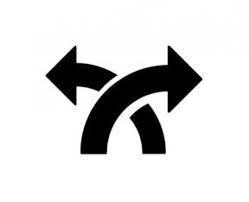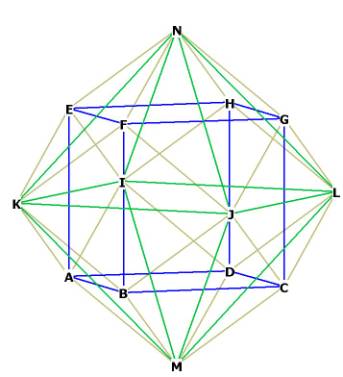|
(2019
midterm assignment) Model Midterm answers 2019 (Index) Essay 3: Web Highlights |
 |
Heidi Kreegeer
Art Imitates Life: Duality in Futuristic Literature and the Human
Condition
One of my most defining characteristics is a compulsion to see the world, life
and human connections as existing on an endless spectrum of grey. There are very
few things, if any, that I believe deserve a black and white answer. This is
because people have always appeared to me as a combination of both good and bad,
caring and hatred, selfless and selfish. Therefore it is no surprise to me that
good future narratives employ both sides of humanity in their imagination of
what is to come of us. What did surprise me was that some of my peers were able
to pick up on aspects of this duality that I had not.
I was very aware throughout lecture that the concepts of a utopia or dystopia
were connected to our conflicting needs and desires as a whole, but it wasn’t
until I read Sarah Nava’s essay “Getting to the Final Destination” that I
embraced the idea of high tech and low tech narratives as being an example of
this as well. She did an excellent job conveying the desire that mankind has for
innovation while they maintain an equally strong desire to hold on to aspects of
their past. But beyond this assertion, the more complex idea is that narratives
which contain both high and low tech characteristics are the ones which “offer
relationships and hope for the future so that readers can digest the story
through an understanding of what makes us human.” It is this ability for the
reader to relate to what they know humanity to be that is so important to the
reader’s investment in the story. Nava also quotes an essay by Melissa
Holesovsky where she states this idea quite beautifully: “low tech scenario[s]
of science fiction writing has a warm feeling of reality…while high tech has a
cold disconnection from the real world.” The low tech aspects offer an anchor
from which the reader can relate and understand, while the high tech aspects
offer imagination, excitement, and perhaps even a little fear. All of these
elements come together beautifully amongst themselves but also work well when
exploring where human nature will take us in the future. Any path we choose to
take will almost certainly be both good and bad, and a product of both our
selflessness and our selfishness.
Another peer who is as preoccupied with the concept of humanity as I am is Mark
Stapelfeldt, whose essay “Humanity Recalled” offers many insights into mankind’s
duality. In it, he recognizes some of what Nava was saying about needing both
high and low tech narratives he states “History shows that people are afraid of
change, and are mostly hostile towards things different from them.” I believe
his point is that we would likely wage war with aliens but it also describes our
aversion to change and how that will create both high a low tech aspects in the
future. He also gives examples of some of our baser or more selfish tendencies
such as the fact that most alien life in these stories are depicted as humanoid,
an obvious play to our own egos. He also expresses concern that any future space
exploration would be equivalent to 'manifest destiny', as human nature drives us
to want "to colonize everything." This is a highly probable example of how human
selfishness could manifest in our future, for better or worse. Overall,
Stapelfeldt drew the conclusion that while he "understand[s] the want and need
to progress as a human species, [he] cannot agree with the path it is heading
towards." While somewhat bleak, I appreciate the attention given to humanity's
selfish nature and the exploration of the future consequences thereof. I
especially appreciate his pointing out the ego involved with the standard
humanoid alien, which had not previously occurred to me.
Timothy Morrow wrote the most insightful essay I could find on this topic,
entitled “A Phoenix Must First Burn: Analyzing Decline in Future Narratives”, in
which he does an amazing job arguing that narratives of the future are defined
by decline coexisting with advancement. In my opinion this fusion of decline and
advancement is the physical embodiment of mankind’s duality, another connection
which I had previously missed. Every example that he uses from the course texts
to connect decline and advancement could also be used to exemplify humanity’s
good and bad qualities. One example given is the Bible, which is an apocalypse
narrative brought on by human sin, and resulting in human goodness prevailing.
In Stone Lives you can clearly see both aspects at play; the horrors of
the bungle only exist because of human/corporate greed but the remedy presented
is also human, Stone himself. The Time Machine also shows
decline/selfishness embodied by the Eloi, who once seemingly enslaved the
Morlocks for their own benefit decline into what is essentially livestock.
Alternately, the selflessness of the Morlocks (voluntary or not) lead to their
eventual advancement and domination of Earth. The Time Machine is a
personal favorite because at first glance it would appear to be the other way
around, and that the Eloi were in fact the “good” ones. Despite humanity’s
duality, I believe that there is one human characteristic that rises above all I
have spoken about and Morrow echoes my sentiments again when he says that a
“reader yearns for the romantic narrative and seeing good overcome evil
ultimately.”
There is never an end to what you can learn if you care to look, and one of my
favorite things about this class is how it reinforces that learning can come
from anywhere and anyone. Peers are too often overlooked for what their insights
can offer and for that reason I always enjoy reading over their work and being
inspired by new topics and ways of thinking. The fact that every person is a
combination of good and bad leads to infinite possibilities of where
civilization will take us. Narratives of the future are the perfect outlet for
exploring these possibilities and the nature within ourselves.
 |
 |
 |
